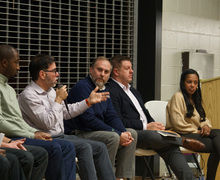Using gender neutral pronouns shows respect for people’s identities, experiences and humanity
Daily Orange File Photo
Gender neutral pronouns and identities can have various meanings for different individuals who use them.
Not so many years ago, the world of gender for many people was black and white. The general public’s view on gender could be summed up by the questions asked on surveys, government forms, social media apps and websites: Are you a man or a woman?
In recent years, however, more attention has been brought to the existence of gender-nonconforming identities, particularly people who use gender neutral pronouns.
In 2014, for example, Facebook added over 50 gender options to give its users a wider array of identities to describe themselves. Dating services like Tinder and OkCupid have allowed for users to identify themselves outside the gender binary. Singer Sam Smith and Queer Eye star Jonathan Van Ness have come out as non-binary this year. And just last month, Merriam-Webster announced the addition of “they” as a singular pronoun.
These new developments, though, are not the mark of a trend or fad, but rather the expression of identities that have always existed but until recently have been severely underrepresented.
“I know a lot of dating apps, they ask for pronouns, or they will ask you if you identify as a man, woman, non-binary, genderqueer,” said Jonathan Chau, a junior studying magazine journalism at Syracuse University, who uses they/them pronouns.
In 2016, The Sims introduced a new interface that allows players to change sex and gender-related characteristics of the characters they create, including preferences for masculine and/or feminine clothing, their physical frame and their ability to become or not become pregnant, becoming one of the first games to allow for transgender and non-binary character expression.
In July of this year, the California city passed legislation replacing all gendered terms in their city code with gender neutral ones, such as “firefighters” in lieu of “firemen” or “firewomen,” or “people” in place of “men and women.”

Karleigh Merritt-Henry | Digital Design Editor
It can be difficult to estimate exactly how many people identify as gender-nonconforming, or how many use gender neutral pronouns. There is no one term that uniformly applies to all those who identify outside the boundaries of male or female, and not everyone who uses gender neutral pronouns necessarily identifies as non-binary or genderqueer.
“Unfortunately, Gallup doesn’t ask about gender non-binary. When it comes to a true estimate of the country’s non-binary population, data are scarce,” said Rachel Dowd, communications director at the Williams Institute at UCLA, a think tank devoted to research on sexual orientation and gender identity-related public policy.
However, gender non-conforming identities are not simply the result of a new trend. Non-traditional gender expression and identity have always existed, even if not everyone has been aware of their existence or had the words to describe them.
“Is this a trend? The answer is no, it’s not a trend. But it’s gotten to different people at different times,” said Gilles Stromberg, who works as an undergraduate recruitment specialist at Syracuse University’s College of Visual and Performing Arts.
Stromberg led a workshop this past Wednesday, which was International Pronouns Day, to help faculty at the university learn more about the use of gender neutral pronouns, become more comfortable using those pronouns and navigate gender nonconforming identities.
Gender neutral pronouns and identities can have various meanings for different individuals who use them.
“Gender neutral pronouns are important, as markers of identity, as theoretical points, and as political solidarity,” said Margaret Himley, the director of the LGBT studies program at Syracuse University, in an email.
Gender neutral pronouns can be used to encapsulate a wide range of experiences, and while no one person’s reasoning may be exactly the same, they have personal significance for those that use them.
“Before 2014, I was living as a woman for more than 24 years. So now, I use they/them pronouns to reflect the reality of my lived experiences, but also to know that I’m living a different experience now,” Stromberg said. “I think the significance of it is that for many folks, it reflects the reality of who they are.”
Using the pronouns a person tells you they want you to use should be no different than referring to a person by their name. Respecting someone’s pronouns shows respect for that person’s identity, experiences and humanity.
Mallory Stokker is a junior magazine journalism major. Her column appears bi-weekly. She can be reached at mstokker@syr.edu. She can be followed on Twitter @_malloryyrose_.
Published on October 28, 2019 at 3:44 am





